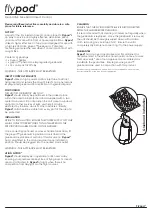
1.2
R
Figure 2
Figure 4
Figure 3
Figure 1
A
B
C
Top
(closest to Pivot Pin)
Most Responsive Setting
Middle
Moderately Responsive
Bottom
(furthest from Pivot Pin)
Least Responsive
80 - 120 lbs.
120 - 220 lbs.
(36 - 54 kg.)
220 - 250 lbs.
(54 - 100 kg.)
(100 - 113 kg.)
Beginner / Partial Inversion
Suggested for Full Inversion
Roller Hinge Selection Per User Weight
Ready for use
B C
A
Bed rotated for adjusting the
Roller Hinge Setting
BEFORE YOU INVERT
make sure that the inversion table rotates
smoothly to the fully inverted position and back, and that all fasteners are secure.
Make sure the user settings described below are properly adjusted for your
unique needs and body type. Take your time finding your proper
settings and remember them.
Check these settings every time prior
to using the equipment.
Roller Hinges: Find Your Setting
The Roller Hinges control the responsiveness or rate of rotation.
There are three holes; the hole selection depends both on your
body weight and the rotational responsiveness you desire
(diagram below). For users just learning to use the inversion table, we
recommend starting with Setting C (Figure 1), the least responsive rotation setting.
Height Setting: Adjust the Main Shaft
The height settings are labeled on the Main Shaft in both inches and centimeters.
• Pull out the Height-Selector Locking Pin with your right hand while sliding the Main
Shaft
with your left (Figure 2).
• Slide the Main Shaft
until the last setting you can read is one inch greater than your
height. e.g. If you’re 5’10” (178 cm) the last numbers you’ll be able to read will be
5’11” (180 cm).
NOTE: The best height setting for you will depend on your weight distribution and
could vary one or two inches on either side of your actual height. Starting at one or two
inches more than your height will help to ensure that the rotation of the table is not too fast.
• Release the Height-Selector Locking Pin so that it fully engages in a hole.
Angle Tether: Adjust to Desired Angle
For first time users, attach the Angle Tether to the U-Bar under the Table Bed (Figure 3)
to
help control your angle of rotation. You can increase the angle of rotation allowed by the
Angle
Tether as you become more comfortable using the table, or remove it for full inversion.
Ankle Comfort Dial: Find Your Setting
The Ankle Comfort Dial can rotate into a High or Low setting
(Figure 4)
. There is a one inch
height difference between the settings. The setting you select will vary by the type of shoes
you wear and your ankle type. Try inverting in both settings to determine which one is most
comfortable for you.
The Ankle Comfort Dial should be set so the Foam Rollers and Heel Cups are secure
around the smallest part of the ankles (with minimal distance between the Ankle Lock
System and the top of your foot); this will reduce sliding on the Table Bed while inverted.
Prepare to Mount
•
ALWAYS
wear securely tied, lace up shoes with a flat sole, such as a tennis shoe.
•
DO NOT
wear shoes with thick soles, boots, high-tops or any shoe that extends above
the ankle bone, as this type of footwear could interfere with properly securing your ankles.
IMPORTANT:
Set the Roller Hinges
in the same hole
setting on each side.
Refer to Adjustments:
Changing the Roller
Hinge Setting in the
assembly instructions.






















